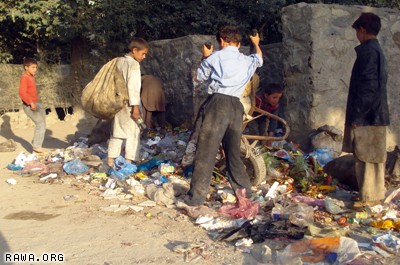Population growth and the construction boom in Kabul over the past few years have resulted in the daily production of over 3,000 tonnes of solid waste. Some of this has been accumulating, causing serious health and environmental damage, according to Kabul Municipality.
The municipality reckons there is now a daily build-up of at least 300 tonnes of solid waste in and around Kabul city (109,500 tonnes annually).

According to the State of the World's Toilets 2007 report, Afghanistan is ranked first as the worst place in the world forsanitation provision as a percentage ofpopulation lacking access. 92% (about 27,500,000 people) lack sanitation in Afghanistan
“On our best working day we collect up to 90 percent of the solid waste from public locations in Kabul city,” Nisar Ahmad Habibi Ghori, director of waste management at Kabul Municipality, told IRIN.
Despite its 2,000 workers and 110 trucks, the municipality says it cannot keep pace with daily solid waste production in Kabul.
“We need more and better resources to keep the city somehow clean,” said Ghori, adding that weak public support for waste management was a “major problem”.
Kabul Municipality dumps tonnes of solid waste and rubbish in the Dashte Chemtala plains, about 7km north of Kabul. However, there is insufficient equipment to dispose of all the solid waste safely.
In fast-growing residential areas in particular, there has been a build-up of waste material, posing a direct health hazard to children who play nearby and/or those who try to eke out a living by scavenging anything of value from the rubbish tips. Wind and rain further spread pollution locally, say experts.
Water-borne diseases
Kabul’s estimated three million-plus residents have no integrated sewage system and according to the State of the World's Toilets 2007 report, Afghanistan’s toilets are “the world’s worst”.
The UN Children’s Fund (UNICEF) estimates that only 12 percent of Afghans have access to sanitation and 23 percent to improved drinking water, and says water-borne diseases such as diarrhoea kill thousands of children annually.
Medical doctors at Kabul’s Indira Gandhi Child Hospital (IGCH) said many children had picked up diarrhoea, dysentery or cholera from contaminated water. “Unsafe drinking water causes almost half of the diseases among children,” said Khalilullah Hodkhil, head of the IGCH.
The city’s once teeming River Kabul has now dried up and is a repository for waste and a source of disease. Officials in Afghanistan’s National Environmental Protection Agency have requested US$5 million to clean up the river.
“Uncollected waste pollutes the air and also produces various harmful vermin,” Kabul Municipality’s Ghori said.



